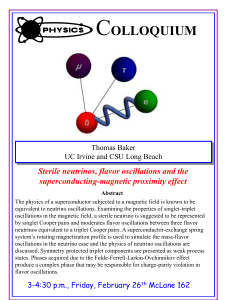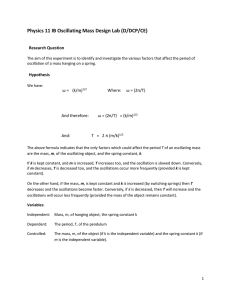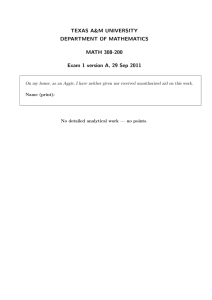SPECTRAL CHARACTERISTICS OF SPONTANEOUS OSCILLATIONS IN CEREBRAL HAEMODYNAMICS ARE POSTURE DEPENDENT Ilias Tachtsidis
advertisement
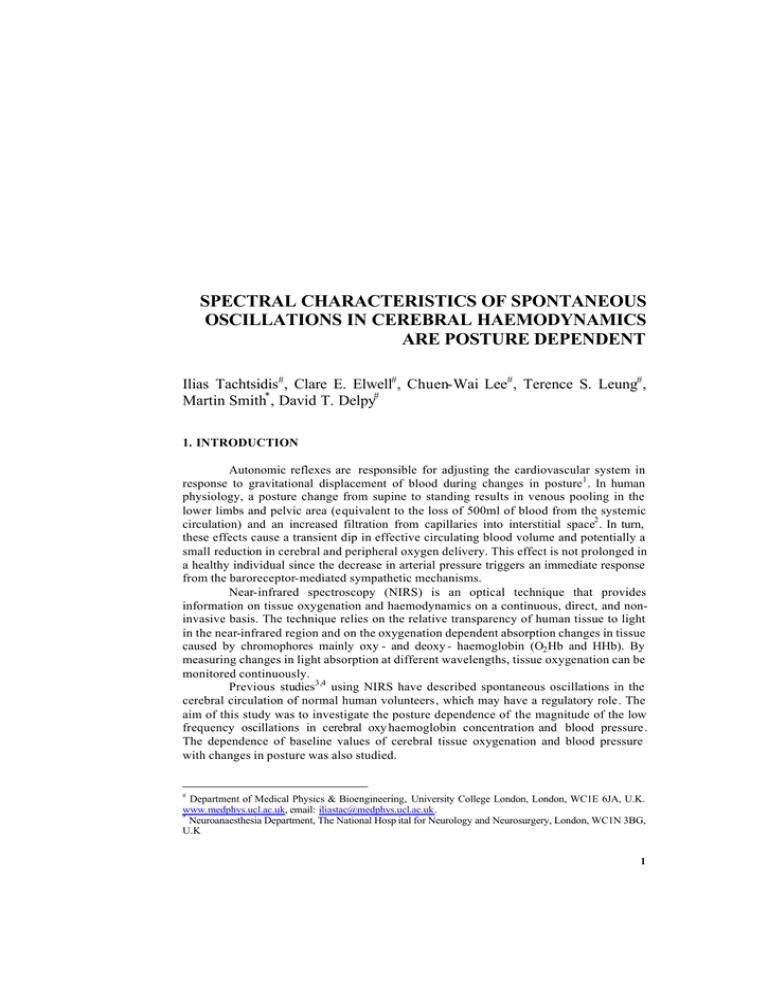
SPECTRAL CHARACTERISTICS OF SPONTANEOUS OSCILLATIONS IN CEREBRAL HAEMODYNAMICS ARE POSTURE DEPENDENT Ilias Tachtsidis# , Clare E. Elwell# , Chuen-Wai Lee# , Terence S. Leung# , Martin Smith* , David T. Delpy# 1. INTRODUCTION Autonomic reflexes are responsible for adjusting the cardiovascular system in response to gravitational displacement of blood during changes in posture1 . In human physiology, a posture change from supine to standing results in venous pooling in the lower limbs and pelvic area (equivalent to the loss of 500ml of blood from the systemic circulation) and an increased filtration from capillaries into interstitial space2 . In turn, these effects cause a transient dip in effective circulating blood volume and potentially a small reduction in cerebral and peripheral oxygen delivery. This effect is not prolonged in a healthy individual since the decrease in arterial pressure triggers an immediate response from the baroreceptor-mediated sympathetic mechanisms. Near-infrared spectroscopy (NIRS) is an optical technique that provides information on tissue oxygenation and haemodynamics on a continuous, direct, and noninvasive basis. The technique relies on the relative transparency of human tissue to light in the near-infrared region and on the oxygenation dependent absorption changes in tissue caused by chromophores mainly oxy - and deoxy - haemoglobin (O2 Hb and HHb). By measuring changes in light absorption at different wavelengths, tissue oxygenation can be monitored continuously. Previous studies3,4 using NIRS have described spontaneous oscillations in the cerebral circulation of normal human volunteers, which may have a regulatory role. The aim of this study was to investigate the posture dependence of the magnitude of the low frequency oscillations in cerebral oxy haemoglobin concentration and blood pressure. The dependence of baseline values of cerebral tissue oxygenation and blood pressure with changes in posture was also studied. # Department of Medical Physics & Bioengineering, University College London, London, WC1E 6JA, U.K. www.medphys.ucl.ac.uk, email: iliastac@medphys.ucl.ac.uk. * Neuroanaesthesia Department, The National Hosp ital for Neurology and Neurosurgery, London, WC1N 3BG, U.K 1 2 2. METHODS 2.1 Experimental methods 10 healthy volunteers of mean age 24±6 years took part in this study (the local ethics committee approved the protocol for the study, and all subjects gave informed consent for participation). A continuous wave near-infrared spectrometer (NIRS), which incorporates spatially resolved spectroscopy and a sampling rate of 6Hz (NIRO 300, Hamamatsu Photonics KK) was used to measure the absolute cerebral tissue oxygenation index (TOI)5 and changes in O2 Hb and HHb over the frontal cortex. The probe was placed on the forehead (taking care to avoid the midline sinuses) and was shielded from ambient light by using bandages and black cloth; the experiments took place in a darkened room. An optode spacing of 5 cm was used and the differential pathlength factor6 was assumed to be 6.26. A Portapres® system (TNO Institute of Applied Physics, Biomedical Instrumentation) was used to continuously measure non-invasive blood pressure from the finger. The measurement is performed on two (adjacent) fingers alternately at selectable intervals to prevent the build up of metabolites in one finger. The data was collected to a PC via a serial link at 100 Hz sampling rate, then a full beat-to-beat analysis was performed with the manufacturers Beatscope software in order to derive mean blood pressure (MBP), diastolic and systolic blood pressure (DBP and SBP). The DBP signal, after extraction and interpolation from the blood pressure signal was resampled to 6 Hz. Each volunteer underwent three postural changes. For the first 10 minutes the volunteer was placed in the supine position, then the subject was required to stand for another five minutes and then to sit down on a chair for a further 10 minutes. 2.2 Power spectral analysis Power spectral density (PSD) provides information on the power of frequencies within a signal as a function of frequency. A non-parametric FFT (fast Fourier transform) algorithm was used on the ∆[O2 Hb] signal as measured by the NIRO 300 and the DBP signal as derived from the blood pressure waveform obtained from the Portapres®. The Welch technique with a Hanning window of 256 sample points (~ 42 second sliding window) and an overlap of 128 points was performed. The signals to be analysed were detrended to remove baseline shifts. The ∆[O2 Hb] data was selected for this PSD analysis since previous studies have shown that oscillations are most prominent in this signal3, 4 . The low frequency (LF) comp onent, defined as 0.04-0.15Hz, was focused upon in this study, as it can be indicative of sympathetic stimulation of the circulation7, 8. The spectral power for this band was calculated from the area under the PSD curve using the trapezoidal method. 3. RESULTS 3.1 TOI and MBP The mean TOI and MBP for all 10 subjects were calculated for a 30 second interval near the beginning of each posture to evaluate a baseline. Paired t-tests showed no significant differences between these baseline signals recorded at each posture. 3 3.2 Power spectral results Figure 1 shows the oscillatory changes in ∆[O2 Hb] and the corresponding power spectral analysis recorded in each posture for one volunteer, typical of the whole group. It can be seen that the changes in the power of the LF component in the PSD are reflected by the increase in amplitude of the 0.1Hz oscillations seen in the raw signal. Power spectral analysis of cerebral ∆[O2 Hb] and DBP from all subjects were carried out. The results of the LF component PSD of the ∆[O2 Hb] and DBP data for each volunteer are shown in Figures 2 and 3. Paired t tests showed a significant increase in the magnitude of the ∆[O2 Hb] oscillations as subjects changed postures from supine to standing (p = 0.012), and between the supine and sitting postures (p = 0.002). A paired t test also showed a significant increase (p < 0.0005) in the magnitude of the DBP oscillations data as subjects changed postures from supine to standing. 4. DISCUSSION This study has shown that the spectral characteristics of spontaneous oscillations in cerebral oxyhaemoglobin concentration are posture dependent in normal volunteers; the magnitude of oscillations in diastolic blood pressure also showed posture dependence. There were no significant differences in bas eline values of tissue oxygenation index or mean blood pressure between different postures. Spontaneous oscillations have been demonstrated in various physiological signals in humans including arterial blood pressure and cerebral blood flow velocity9 . It has been suggested in previous studies that LF oscillations in cerebral haemodynamics (as well as other signals) are representative of the periodic fluctuations present in the microcirculation, a phenomenon known as vasomotion3 . The presence of synchronous fluctuations in signals from different areas of the body suggests the origin of a common regulatory mechanism. LF oscillations in heart rate variability have been shown to increase in strength from supine to 90° head up tilt 7 . The reasons underlying these changes have been thought to be a result of the baroreflex, which suggests the oscillations could be a marker of sympathetic activity7,8 . The posture dependent ol w frequency fluctuations (~0.1Hz) in cerebral ∆[O2 Hb] described in this study may be indicative of the changes in sympathetic activity associated with changes in posture. Clinical tests of patients with orthostatic hypotension due to sympathetic failure involve tilting the patient through different postures. We believe that the posture dependence of the low frequency oscillations described here may provide information about regulatory control in different groups of autonomic failure patients. A clinical trial is currently underway to investigate the use of this analysis tool in the study of patients with orthostatic hypotension due to sympathetic failure. Although we have concentrated our analysis around the defined low frequency band, the power spectrum of the ∆[O2 Hb] and DPB signal shows oscillations in a variety of frequency bands including very low frequency (VLF) (0.02-0.04Hz). The physiological explanation of this component is much less defined and the existence of a specific physiological process attributable to this frequency range might be questioned. Furthermore the non-harmonic component which does not have coherent properties and which is affected by algorithms of baseline or trend removal is commonly accepted as the major constituent of VLF10 . Previous studies have shown the presence of cardiac and 4 respiratory related oscillations in NIRS signals, both of which are outside the LF range considered here 3 . The haemodynamic status of the resting brain, characterised in part by the low frequency oscillations described in this paper, is an important factor when considering measurements of the haemodynamic response of the functionally activated brain 3 . Measurements of the haemodynamic response to functional activation performed using fMRI require the subject to be supine. Measurements of the haemodynamic response to functional activation using NIRS or EEG are generally performed with the patient upright. Our data shows a significant difference, in the resting brain, between the magnitude of these low frequency oscillations in ∆[O2 Hb] with different postures. This posture dependence should therefore be considered when comparing haemodynamic response data collected using different modalities. ACKNOWLEDGMENTS The authors would like to thank all the volunteers participated in this study and Hamamatsu Photonics KK for providing the NIRO 300 spectrometer. This work was supported by the EPSRC/MRC, grant No GR/N14248/01 (IT) and the Wellcome Trust grant No GR/062558 (TSL). LF Figure 1. Raw ∆[O2 Hb] data and the corresponding power spectrum density (PSD) analysis for the low frequency (LF) component for one volunteer with posture changes. 5 LF Power in Cerebral ∆[O2 Hb] with Changes in Postures (µmolar of O2 Hb)^2 / Hz 1.4 1.2 Subject 1 Subject 2 1.0 Subject 3 Subject 4 Subject 5 0.8 Subject 6 Subject 7 Subject 8 0.6 0.4 Subject 9 Subject 10 0.2 0.0 Supine Standing Sitting on Chair Figure 2. LF power of cerebral ∆[O2 Hb] for every volunteer, with changes in postures. LF Power in DBP with Changes in Postures 45 DBP (mmHg)^2 / Hz 40 Subject 1 Subject 2 Subject 3 35 30 Subject 4 Subject 5 Subject 6 25 20 Subject 7 Subject 8 Subject 9 Subject 10 15 10 5 0 Supine Standing Sitting on Chair Figure 3. LF power of DBP for every volunteer, with changes in postures. REFERENCES 1. A. Vander, J. Sherman, D. Luciano, Human Physiology: The mechanisms of body function (WCB McGrawHill, International Ed, 1998). 2. M. Lye, T. Walley, Haemodynamic responses in young and elderly healthy subjects during ambient and warm head-up tilt, Clinical Science, 94, 493-498 (1998). 3. C. E. Elwell, R. Springett, E. Hillman, D. T. Delpy, Oscillations in cerebral haemodynamics - implications for functional activation studies, Adv. Exp. Med. & Biol., 471, 57-65 (1999). 4. H. Obrig, M. Neufang, R. Wenzel, M. Kohl, J. Steinbrink, K. Einhaupl, A. Villringer, Spontaneous low frequency oscillations of cerebral haemodynamics and metabolism in human adults, NeuroImage, 12, 623-639 (2000). 5. S. J. Matcher, P. Kirkpatrick, K. Nahid, M. Cope, D.T. Delpy Absolute quantification methods in tissue nearinfrared spectroscopy. Proc SPIE 2389, 486-95 6. A. Duncan, J. H. Meek, M. Clemence, L. Tyszczuk, M. Cope, and D. T. Delpy, Optical pathlength measurements on the adult head, calf and forearm and the head of the newborn infant using phase resolved optical spectroscopy, Phys. Med. Biol., 40, 295-304 (1995). 6. 7. Task force of the European society of Cardiology and the North American Society of Pacing and Electrophysiology, Heart rate variability: standards of measurement, physiological interpretation and clinical use. European Heart Journal, 17, 354-381 (1994). 8. G. Preiss, C. Polosa, Patterns of sympathetic neuron activity associated with Mayer waves. Am J Physiol, 226(3), 724-730 (1974) 9. T. B. J. Kuo, C. M. Chern, W. Y. Sheng, W. J. Wong, H. H. Hu, Frequency domain analysis of cerebral blood flow velocity and its correlation with arterial blood pressure. J Cereb Blood Flow Metab 18,311-318 (1998) 10. T. Müller, M. Reinhard, E. Oehm, A. Hetzel, J. Timmer, Detection of very low-frequency oscillations of cerebral haemodynamics is influenced by data det rending. Med Biol Eng Comput, 41, 69-74 (2003)

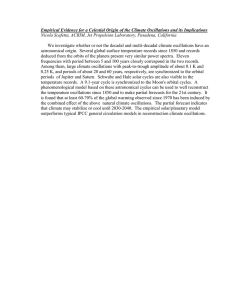


![Solar Forcing and Abrupt Climate Change over the Last 100,000... Jose A. Rial [] and Ming Yang [], University of](http://s2.studylib.net/store/data/012739005_1-c337c3e26293ae14faa36e511979b340-300x300.png)
